 | |
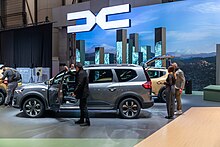 Dacia stand at the 2024 Geneva International Motor Show Dacia stand at the 2024 Geneva International Motor Show | |
| Company type | Subsidiary |
|---|---|
| Industry | Automotive |
| Founded | September 1966; 58 years ago (1966-09) |
| Headquarters | Mioveni, Argeș, Romania |
| Area served | Europe (except Armenia, Azerbaijan, Belarus, Georgia, Russia, Ukraine), Algeria, Israel, Lebanon, Morocco, Overseas France and Tunisia |
| Key people |
|
| Products | Automobiles, commercial vehicles |
| Production output | |
| Revenue | (€5,233 million) (2023) |
| Operating income | |
| Net income | |
| Total assets | |
| Total equity | |
| Number of employees | |
| Parent | Renault |
| Website | dacia |
S.C. Automobile Dacia S.A., commonly known as Dacia (Romanian pronunciation: [ˈdatʃi.a] ), is a Romanian car manufacturer that takes its name from the historical region that constitutes present-day Romania. The company was established in 1966. In 1999, after 33 years, the Romanian government sold Dacia to the French car manufacturer Groupe Renault. It is Romania's largest company by revenue and the largest exporter, constituting 8% of the country's total exports in 2018. In 2021, the Dacia marque sold 537,074 passenger and commercial vehicles.
From January 2021 onwards the Dacia company became part of Renault's Dacia-Lada business unit. In May 2022, Renault sold Lada's parent company AvtoVAZ to Russian state-owned institute NAMI.
History
The first facility in the area was built between 1942 and 1945, as an extension of the IAR aircraft manufacturer. The new factory, built in the Colibași-Pitești area under the order of Marshal Ion Antonescu (conducător of Romania during World War II), was scheduled to produce up to 600 aircraft engines per month. The building work was completed in 1945. After the war, the facility was taken over by the Romanian Railways, later generating the Dacia plants.

Founding
The Dacia automobile company was founded in 1966 under the name Uzină de Autoturisme Pitești (UAP). The main Dacia factory was inaugurated in 1968, in Colibași (now called Mioveni), near Pitești. Dacia acquired the tooling and basic designs of the Renault 12. However, until the tooling was ready it was decided to produce the Renault 8 under licence; it was known as the Dacia 1100. From 1968 to 1972, 37,546 cars of model 1100 were produced, with a very minor cosmetic change to the front in early 1970. Also produced in very limited numbers was the 1100S, with twin headlamps and a more powerful engine, used by the police and in motor racing.

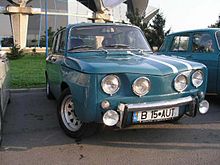

The first Dacia 1300 left the assembly line ready for the 23 August parade in 1969, and was exhibited at the Paris and Bucharest shows of that year. Romanians were delighted with the modernity and reliability of the car, and waiting lists were always lengthy. By 1970, there were two variants: the standard 1300 and the 1300L (for Lux); in 1974 the 1301 Lux Super was introduced, which had novelties such as a heated rear screen, a radio, wing mirrors on both sides and a more luxurious trim. This was reserved for the Communist Party nomenklatura.
Changes soon followed as export markets opened up. In 1973, the estate variant, 1300 Break, was produced. There were 1300F (estate with no rear seats, for carrying goods) and 1300S (ambulance) variants, and in 1975 the Dacia 1302 pick-up was developed. 2,000 units were made until 1982.
Dacia also produced the Estafette, a complete knock-down version of the Renault Estafette van, in limited numbers, but given the competition of the Bucharest-made T.V. van, numbers were very limited. In the very early 1980s, the Renault 20 was also assembled as the Dacia 2000; because of the exclusivity of this model numbers were always very limited. The 2000 was only available in dark blue or black, and was reserved for the Party elite. In 1978 plans were revealed for the Renault 18 to be assembled by Dacia, but the Renault contract lapsed and Dacia went its own way.
At the Bucharest show in 1979, the restyled 1310 models were presented. These had quad lamps at the front, larger lamps at the rear, re-profiled bumpers, and a new interior. The changes were heavily inspired by Renault's own restyling of its 12 in 1975. After a brief series of "crossover" cars in 1981 (for example, there were no more rectangular headlights available for the 1300, so the last models used the quad lamps of the 1310), the 1310 hit the Romanian market in late 1981. In the UK, where it was known as the Dacia Denem, the top of the range model included such luxuries as a five-speed gearbox, alloy wheels and electric windows. The advertising slogan used for the car was "The Very Acceptable Dacia Denem". Sales were very limited, and the number surviving are not thought to exceed ten, although the Romanian Embassy in South Kensington kept a fleet running until the mid-1990s. Sales of the pick-up version, known as the Shifter, continued until the 1990s, and the ARO 10 was also sold as the Dacia Duster. Production was stopped in late 1982.
At the same time the Sport model was produced. At the 1980 Bucharest international trade fair, crowds admired the Brașovia, a prototype of a sports coupé based on the 1310 and developed at a service station in Brașov. The go-ahead was given for a prestige model, and so from 1983 the two-door Dacia 1310 Sport (and later the 1410 Sport), was available for general consumption. These were popular for rallies, and racing drivers such as Nicu Grigoraș tuned them to extract extraordinary power from the old Renault engine.
1980s
The designers were still coming up with fresh ideas, many of them shrouded in secrecy. Prototypes such as the 500cc Mini-Dacia, as well as Dacia 1310 variants, were designed; some, such as the Dacia 1310 Maxi Break, are still on the road. These cars are eagerly prized by Dacia enthusiasts, and Dacia web forums are full of evidence about the rarities and oddities produced by Dacia during the 1980s. The Maxi Break was an eight-seater version of the station wagon (also available as an ambulance), stretched by about a half a metre between the doors. 10–12 such cars were actually built, by Dacia Service Pitesti.
In 1982, after the 1302 was dropped, the Dacia 1304 Pick-up and Drop-side models were introduced. Actually, they had been launched from 1981. These were a commercial success and remained in production, gradually being modified along with the rest of the range, until December 2006. In 1985 were added the 1410 was available as a larger-engined variant, while the relatively short-lived 1210 was the economy variant until about 1992.

For the 1984 model year, the de luxe MS and MLS models presented slight modifications on the 1310 platform, with a new spoiler and chunkier, rubber mouldings around the front grille and headlamps. In 1985, the rear vent was changed from a narrow horizontal aperture to a rhomboid aperture, much like that of the Renault 12 phase 2. From late 1985 all models had the large rubber mouldings around the front grille and headlamps, plus a spoiler: the line-up was changed to TX ( 1289 cmc engine and 4 speeds gearbox ) and TLX(1397 cmc engine, 5 speedsgearbox) though other designations were occasionally seen. A five-speed gearbox also became an option. Models destined for Canada (initially called GTL) sported twin fuel tanks. In parallel, work was developing on the 1320 CN1 model, which was a hatchback based on the 1310.
The new front end seen on the 1320 also appeared on the top-of-the-range and special-order models from about 1986; these cars were distinguishable by two large headlights, a much plusher interior clad in blue plastic and a new dashboard known as the CN1, and – occasionally – faired-in door handles. Many were owned by senior officials in the Communist Central Committee. While the 1320 was the most expensive model in the Dacia range when it appeared in 1988, many were used as taxis. The 1320 did not last long, however; as early as 1989 there were prototypes using the front of the 1320 and a new rear, with wrap-around tail lights and other relatively modern features.
1990s
The 1320 model was replaced in 1991 by the Dacia 1325 Liberta (after the 1989 revolution, themes of liberty were very much in fashion) and stayed in production until 1996. The last of the quad-lamped models were produced in 1992, and all the Dacia range received the new front end of the 1320, called CN1. An effort was made to rejuvenate the model range: the Sport was dropped, due to lack of sales, and new commercial vehicles were introduced. The 1307 was a double-cabbed pick-up; the 1309 was an estate with a tarpaulin instead of a boot; the car was a cross-over between estate and pick-up and sold very well on the Chinese market. There were also several prototypes, including:
- the 1610 diesel estate, powered by Volkswagen, with about 150 units sold
- the Dacia Star, with curved side windows
- the 1308 Jumbo, a camper-van, and several attempts to give the 1310 a more modern look by grafting the front of contemporary cars such as the Nissan Primera onto it.
The cars of 1992 to 1994 are curiosities: although efforts were obviously being made to renew the model range, there were numerous stylistic hangovers from the quad-lamped models. Thus, the last of the 1983-designed dashboards were seen in 1994 although a new dashboard had been seen on some model ranges since 1987. Similarly, although the CN1 restyling eliminated anachronisms such as a kink upwards at the C-pillar and a rubber rear spoiler, it was not applied consistently.
The 1994 facelift was known within the industry as CN2. A reprojected front end was distinguished by a horizontal metal line in the grille. There were new headlamps, a new radiator grille, and front and rear bumpers. Inside, there was a new dashboard for the base models, while the top-of-the-range cars had luxuries such as body-coloured bumpers, rear head restraints, a radio-cassette, hubcaps, and the ever-present CN1 dashboard, this time in black plastic. This model was not to stay in production for very long; in 1995 the CN3 type was introduced. Practically the only differences were those of trim level and the radiator grille.

From late 1994 little attention was paid to the improvement of the 1310 range, as Dacia launched a new model, the Dacia Nova. This was a compact saloon/sedan or hatchback with a three-box design. The design was rather outdated, because development work had started in 1983. The Nova started after the end of any French involvement in Dacia. The model was unpopular, due to reliability and rustproofing issues. However, after improvements in 1996, the Nova became more often seen on Romanian roads. In 1998 a seven-seater prototype was produced using the panels and windows from the standard Nova saloon.
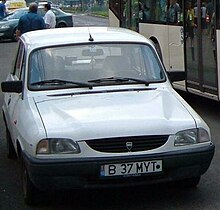
In 1998, the anniversary year of three decades of production since the first Dacia rolled off the assembly line, vehicle number 2,000,000 emerged from the plant; this year saw the last restyling of the 1310. It was known as CN4 and involved a comprehensive restyling of the front end, new door handles, and a lightly restyled rear view mirror. The estate version was fitted with larger tail lights. Even though the model was over thirty years old, it sold exceptionally well due to a starting price of about 4,200 euros and high availability of parts. "Goodies" such as a fuel-injection also helped keep the model relatively modern.
In 1999, a special edition was produced for the first time, known as Dacia Dedicație. This luxury version of the saloon and estate had alloy wheels, body-coloured bumpers, power steering, electric windows, and a far better level of finish. The models were all painted two-tone silver, and sold at a significantly higher price. From 2002, the cars became known as Berlina and Break, with the 1310 lettering being relegated to an insignificant position underneath the side light.
On 21 July 2004, the last models of the 1300 series rolled out the gates of the Mioveni production facility, one month before their 35th anniversary. The last Dacia 1310 (saloon version), number 1,979,730, will be kept in the Dacia Museum.

On 8 December 2006, the utility Dacia Pick-Up suffered the same fate. Although many improvements had been made in recent years, such as four-wheel drive, the introduction of a 1.9 diesel engine, the dashboard from the Dacia Solenza (also seen on the last 1310s) and wheels fastened by five studs as opposed to three, Romania's entry to the European Union effectively prevented the continued production of the old models. The assembly lines were remodelled and expanded to increase production of the Dacia Logan.
In over 34 years of production, and more than 2.5 million units produced, the Dacia 1300/1310 easily became the most common car on Romanian roads. A large number of people had become adept at carrying out repairs or home-made modifications. For example, many older cars had newer front ends grafted onto them to make them seem more modern, or purely because newer parts were easier to get. Consequently, original early 1300s are quite rare, with prices steadily increasing for the best-preserved models. Tuning of Dacias is also a popular pastime, although the home-made nature of much of the work casts doubt on the level of quality, safety and reliability of the finished product.
According to popular belief, during the Communist era, in the plant where Dacias were made, there were two assembly lines: one line producing Dacias intended for sale in Romania and the other line producing the same car (albeit from superior parts, and assembled with greater care) for export. Romanians living near the border would commonly purchase their Dacia in neighbouring countries expecting a higher level of quality.
Acquisition by Renault

Meanwhile, work was continuing on the other Dacia models. In September 1999, Dacia became the third brand of the Renault group, with a view to making Romania its hub of automobile development in Central and Eastern Europe, and investment was consequently increased. The first sign of this came in 2000, with the introduction of the SupeRNova, an improved version of the Nova with engine and transmission from Renault. The top-of-the range version had air conditioning, electric windows and a CD player. Sales were very good, although the outdatedness of the concept was striking. Dacia sold 53,000 vehicles in 2002, an almost 50 per cent market share in Romania.
In 2003, a restyled version replaced the SupeRNova with Dacia Solenza, featuring a new interior, the options for an airbag. This was, however, only meant to be a stopgap model filling the need for a saloon model before the introduction of the all-important Dacia Logan, as well as to familiarise workers with the demands of manufacturing a model acceptable to Western European markets. Production was stopped in 2005.
2004–2011



The Dacia Logan is the most successful model since the original 1300. It was introduced after considerable media interest in August 2004, and despite design-related criticism, it became one of the top-selling cars in Central and Eastern Europe, as well as Russia. The Logan is sold in many countries, occasionally under the Renault brand. It was awarded 3 (out of 5) stars in NCAP crash testing. It remains by far the best-selling car in Romania, comprising a 43% share of Dacia's total Romanian sales in 2015. A diesel version was also introduced in 2005. Before its launch, it was known as the 5000-Euro car due to its projected launch price. This was never quite the case, although it is one of the cheapest cars for its size on the market.
In 2006, the prototype Logan Steppe was exhibited. This showed a speculative 4×4 estate version of the Logan. The estate version was launched in late 2006. The van, basically an estate with the rear windows filled in and a separate cabin for the driver, was launched in February 2007 after the stopping production of the classic utility vehicle, the Dacia Pick-Up.
The Renault Technologie Roumanie engineering centre was set up in 2006, in Bucharest, Romania. Employing approximately 2,500 engineers, its main fields of activity are the development, testing and design of the new vehicles in the Dacia range, as well as the marketing and technical support. The following year, the company also set up a styling office, Renault Design Central Europe.

A pick-up model and the Logan-based hatchback Sandero were launched in 2008, the latter at the Geneva Motor Show. This also marked a point of rebranding for the company, which adopted a new logo and later the same year launched the facelifted Logan model.
In 2009, a new concept called the Dacia Duster was unveiled at the Geneva Motor Show, signaling manufacturer's intentions of releasing an SUV model. This was reportedly the inauguration of the platform that would be used for the second generation of the Logan and Sandero models, released in 2012.
In 2010, the Dacia Duster was exhibited at the Geneva Motor Show. It is the first crossover SUV built by Dacia since the Renault acquisition, in 4×2 and 4×4 versions. It was revealed on 8 December 2009, and became available in Europe on 18 March 2010.
In September 2010, a testing center was opened in Titu, Romania, as part of Renault Technologie Roumanie. It is intended for developing and optimizing the new vehicles in the Dacia range and has nine types of track with a total length of 32 kilometres and around 100 test benches, used to test the resistance of vehicles and replacement parts to cold, heat and rain.
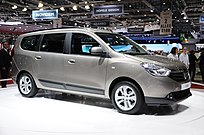 Dacia Lodgy
Dacia Lodgy Dacia Dokker
Dacia Dokker
2012–2020
In 2012, Dacia Lodgy, a new compact MPV, was revealed at the Geneva Motor Show. It is based on a new platform and is manufactured at an all-new Renault factory in Tangier, Morocco.
The Dokker, released in June 2012, is a slightly smaller leisure activity vehicle, also manufactured in Tangier, sharing the same platform with the Lodgy, available in passenger and panel van variants.
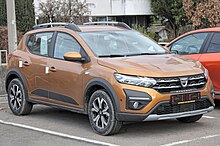
In September 2012, the second generations of the Logan and Sandero were revealed at the Paris Motor Show. They feature a common front end design and come with improved standard safety features, a new engine and other new comfort equipment.
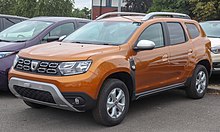
The following year, the facelifted Duster was presented at the Frankfurt Motor Show. It received mild modifications to the front and rear ends, the new interior introduced on the new Logan and Sandero models, as well as a new turbocharged petrol engine.
At the 2017 Frankfurt Motor Show, the second generation Duster model was introduced, bringing new comfort and technical improvements, but retaining similar dimensions and engines.
According to reports, in September 2018, Automobile Dacia gained the 14th place in Top 500 CEE companies.
Dacia's CEO from April 2016 until May 2018 was Yves Caracatzanis. He was replaced by Antoine Doucerain, who left after only four months due to "personal reasons". After a brief stint by interim manager Jerome Olive, the position was filled by Christophe Dridi in December 2018.
In 2020, Dacia announced that they would be releasing an electric car which they showcased in March 2020 with the Dacia Spring Electric concept. The Dacia Spring is said to be based on the Renault City K-ZE and is set to become the cheapest electric car in Europe with the price being estimated by Romanian media at around €15,000 to €20,000.
2021–present
In January 2021, Denis Le Vot became the CEO of the Dacia-Lada business unit. As part of a company revamp, Renault said it would integrate the Dacia and the Lada marques into a new business unit. It also unveiled a new Dacia logo and a product offensive for the Dacia marque, widening its market segments coverage.
In March 2021, the production version of the Dacia Spring EV was shown at the Renault eWays event by Groupe Renault Executive Denis Le Vot. The Spring will be sold in left-hand drive areas of Europe, alongside updated Sandero and Logan models (announced at the end of 2020) and will have a car-sharing version called the Spring Business.
Facilities
The company's single plant is located in Mioveni, Romania, together with its headquarters, and has a production capacity of 350,000 vehicles per year. It is divided into several sections, such as bodywork, painting, assembly, mechanical and chassis, foundry etc. It works in conjunction with the Renault Technologie Roumanie engineering centre, located in Bucharest and set up in 2006, which also comprises a styling office, Renault Design Central Europe, and with the testing centre located in Titu that was opened in 2010.
A large logistical centre was also set near the plant in March 2005, the International Logistic Network, from where complete knock down (CKD) kits are exported to other Renault production sites in Russia, Morocco, Colombia, Argentina, Brazil, South Africa, Iran and India. It is reportedly the biggest logistic centre of its kind not only in the Renault Group, but in the global automotive industry. In 2012, the total equivalent of the kits sent worldwide from the centre was 920,646 vehicles.
Overseas
Two of the Dacia models, the Lodgy and the Dokker vans, were manufactured at the Renault factory in Tangier, Morocco. The Logan and the Sandero are also manufactured in Casablanca, Morocco, the latter also in Tangier.
Innovation
Faced with the growing demand for automatic gearboxes in Europe and significant demand in Russia, South America and India, Renault has decided to develop a specific automatic gearbox, called Easy-R. Innovative, it replaces hydroelectric technologies (hydraulics controlled by electronics) with electromechanical elements. The result is a more reliable and more affordable automatic transmission. Dacia is indeed offering this equipment from 2015 in Europe at a price of 600 euros, which is at least half the price of the competition. The number of parts has been reduced by a quarter, ensuring better reliability and simplified maintenance. Four modes are available on the Easy-R controlled gearbox, also indicated on the dashboard: D/Drive, N/Neutral, R/Rear and M/Manual impulse. This Easy-R gearbox keeps fuel consumption identical to that of the manual gearbox, while offering the advantages of a traditional automatic gearbox.
Sales
The Dacia brand is marketed in most of the Western and Eastern European countries, as well as in some Northern African countries, such as Algeria, Tunisia and Morocco. Western European exports began in the late 1970s, entering markets like Belgium and the Netherlands in 1978. Its models have also been produced by Renault in its production sites on other continents (in Russia, Iran, India, South Africa, Colombia and Brazil) and sold under its own brand or other specific local brands (such as Mahindra, Lada or Nissan for example ).
In 2012, Dacia sold a total of 359,822 vehicles, of which approximately 230,000 were exported to Western Europe, the most of them in France and in Germany. Besides the domestic market, its other key markets have been Algeria, Turkey, Italy and Spain.
For 2014 the company sold 511,465 vehicles in 43 countries, thus breaking another record and exceeding the 500,000 threshold. On the 6th of May 2014, the main Dacia plant Mioveni produced its five millionth car, approximately the three millionth car since Renault owned the brand.
The 3.5 millionth Dacia car, since the Dacia brand revival ten years before, was sold in the UK in November 2015.
In 2015, the company set a new sales record, with a total of 550,920 units marketed.
Dacia cars sales exceeded 700,000 units in 2018 (7% more than in the previous year).
Figures
The historical sales figures of all the models are the following (under the Dacia brand only):
| Model | 1968–1972 | 1969–2004 | 1986–1992 | 2004 | 2005 | 2006 | 2007 | 2008 | 2009 | 2010 | 2011 | 2012 | 2013 | 2014 | 2015 | 2016 | 2017 | 2018 | 2019 | 2020 | 2021 | 2022 | 2023 | Total |
|---|---|---|---|---|---|---|---|---|---|---|---|---|---|---|---|---|---|---|---|---|---|---|---|---|
| Dacia 1100/1100S | 37,546 | − | − | − | − | − | − | − | − | − | − | − | − | − | − | − | − | − | − | – | – | − | − | 37,546 |
| Dacia 1300/1310 | − | 1,959,730 | − | − | − | − | − | − | − | − | − | − | − | − | − | − | − | − | − | – | – | − | − | 1,959,730 |
| Dacia Lăstun | − | − | 6,532 | − | − | − | − | − | − | − | − | − | − | − | − | − | − | − | − | – | – | − | − | 6,532 |
| Dacia Solenza | − | − | − | 31,431 | 8,354 | − | − | − | − | − | − | − | − | − | − | − | − | − | − | – | – | − | − | 39,785 |
| Dacia Pick-Up | − | 279,184 | − | − | 21,165 | 11,733 | − | − | − | − | − | − | − | − | − | − | − | − | − | – | – | − | − | 312,082 |
| Dacia Spring | – | – | – | – | – | – | – | – | – | – | – | – | – | – | – | – | – | – | – | 1,722 | 27,876 | 48,887 | 61,803 | 140,288 |
| Dacia Logan | − | − | − | 22,868 | 134,887 | 184,975 | 230,343 | 218,666 | 158,251 | 126,841 | 95,365 | 102,196 | 69,355 | 98,601 | 101,628 | 80,506 | 75,319 | 79,229 | 75,532 | 52,782 | 27,136 | 27,398 | ? | 1,961,878 |
| Dacia Sandero | − | − | − | − | − | − | − | 38,928 | 151,206 | 154,406 | 86,578 | 94,180 | 150,672 | 169,055 | 185,846 | 216,543 | 270,191 | 278,925 | 274,375 | 189,354 | 226,825 | 229,495 | 269,899 | 2,986 478 |
| Dacia Duster | − | − | − | − | − | − | − | − | − | 66,939 | 161,203 | 131,205 | 115,405 | 160,467 | 165,275 | 179,215 | 184,112 | 215,977 | 260,119 | 178,091 | 186,001 | 197,058 | 200,633 | 2,401 700 |
| Dacia Jogger | – | – | – | – | – | – | – | – | – | – | – | – | – | – | – | – | – | – | – | – | 26 | 56,812 | 94,095 | 150,933 |
| Dacia Lodgy | − | − | − | − | − | − | − | − | − | − | − | 29,129 | 42,977 | 27,059 | 33,000 | 35,715 | 39,668 | 36,011 | 36,073 | 28,072 | 24,526 | 13,189 | ? | 345,419 |
| Dacia Dokker | − | − | − | − | − | − | − | − | − | − | − | 2,924 | 51,063 | 56,180 | 65,114 | 72,160 | 85,938 | 90,432 | 90,387 | 70,892 | 44,684 | 974 | ? | 630.748 |
| Total | 37,546 | 2,238,914 | 6,532 | 94,720 | 164,406 | 196,708 | 230,473 | 257,594 | 309,457 | 348,269 | 343,230 | 359,822 | 429,534 | 511,419 | 550,912 | 584,139 | 655,228 | 700,568 | 736,486 | 522,635 | 537,074 | 573,813 | 626,430 | 10,973,105 |
Models
See also: List of Dacia vehiclesCurrent
- Dacia Duster Pick-Up (2020–present)
- Dacia Logan III (2020–present)
- Dacia Sandero III (2020–present)
- Dacia Sandero Stepway III (2020–present)
- Dacia Spring Electric (2021–present)
- Dacia Spring Cargo (2021–present)
- Dacia Jogger (2022–present)
- Dacia Duster III (2024–present)
- Dacia Sandrider (2023-present)
Future
Dacia will launch two new models, after the Bigster, by 2025.
- Dacia Bigster (2025)
Former
- Dacia 1100 (1968–1972)
- Dacia 1300 (1969–1979)
- Dacia 1301 (1970–1974)
- Dacia D6 Estafette (1974–1976)
- Dacia 1302 (1975–1982)
- Dacia 1210/1310/1410 (1979–2004; Dacia Denem in the United Kingdom)
- Dacia 1304 Pick Up (1979–2006)
- Dacia 2000 (1980–1982)
- Dacia Duster (1983–1990s; rebadged ARO 10 in the United Kingdom)
- Dacia 1310 Sport/1410 Sport (1983–1992)
- Dacia 1320 (1985–1989)
- Dacia 1305 Drop Side (1985–2006)
- Dacia 500 Lăstun (1988–1991)
- Dacia Liberta (1990–1996)
- Dacia 1309 (1992–1997)
- Dacia 1307 King Cab (1992–2003)
- Dacia 1307 Double Cab (1992–2006)
- Dacia Nova (1994–1999)
- Dacia SupeRNova (2000–2003)
- Dacia Solenza (2003–2005)
- Dacia Logan I (2004–2012)
- Dacia Logan I MCV (2006–2012)
- Dacia Logan Van (2007–2012)
- Dacia Logan Pick-Up (2008–2012)
- Dacia Sandero I (2008–2012)
- Dacia Sandero Stepway I (2008–2012)
- Dacia Duster I (2009–2017)
- Dacia Logan II (2012–2020)
- Dacia Logan II MCV (2012–2020)
- Dacia Sandero II (2012–2020)
- Dacia Sandero Stepway II (2012–2020)
- Dacia Logan II Stepway (2019–2020)
- Dacia Dokker (2012–2021)
- Dacia Lodgy (2012–2022)
- Dacia Duster II (2017–2024)
Prototypes
- Dacia Braşovia coupé (1980)
- Mini-Dacia (1980s) – prototype made from cut-down Dacia 1310 panels and easily changeable from hatchback to pick-up to convertible according to removable panels
- Dacia Jumbo highrise van (1990)
- Dacia Nova minivan (1998)
- Several prototypes of the 1310 with diesel, LPG or smaller engines, throughout the model history
- Dacia Star (1991)
- Dacia 1310 convertible (1987; three produced)
- Dacia 1306 saloon-derived pick-up (1994/5; very small series)
- Dacia 1310 Break Limousine (late 1980s) – stretched estate with seven seats, several produced in normal-roofed and high-roofed variants
- Dacia D33 (1997) – prototype made by IDEA design house in Turin, one model only
- Dacia 1310 4x4 / Aro 12 (late 1980s) – estate-derived 4x4, very small series
- Dacia Duster concept car (2009)
Marketing
Sponsorships
From the 2008–09 season to the 2022-23 season, Dacia was the sponsor of Italian Serie A football club Udinese Calcio and Stadio Friuli.
Dacia became the official car partner of the Rugby League Super League and the Challenge Cup in February 2016 and then deepened their support of the sport by becoming the main sponsors of the men's, women's and wheelchair England teams in June 2017. They also became the principal partner of the Great Britain Rugby League Lions in 2019 for the team's four match tour of New Zealand and Papua New Guinea.
Gallery

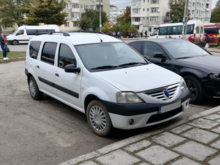




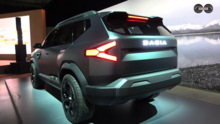
Notes
- Only Dacia-badged vehicles manufactured by the Dacia company at the Mioveni plant, excluding other Renault subsidiaries.
- Including "Others" sales figures.
- ^ Including "Misc." sales figures.
References
- "Dacia goes on sale in Israel – the brand's 44th market". 7 January 2015.
- "Dacia Lebanon". www.dacia-liban.com. Retrieved 30 July 2023.
- "Dacia Tunisie - Constructeur Automobile - Gamme - Services - Concessionnaires". www.dacia.tn.
- ^ "Automobile Dacia S.A. Consiliul de Administrație. Raport de gestiune. 31 decembrie 2023" [Automobile Dacia S.A. Board of Directors. Management report. 31 December 2023] (PDF) (in Romanian). Groupe Renault Romania – Dacia. pp. 9, 11–12. Retrieved 22 July 2024.
- "Automobile Dacia Official Site". Dacia. Archived from the original on 9 September 2010. Retrieved 12 October 2010.
- "Topul celor mai mari corporaţii din lume. Doar o treime din cele mai mari 100 sunt prezente şi local. Fiecare din primele şapte are venituri mai mari decât cifra de afaceri totală a companiilor din România – Ziarul Financiar". www.zf.ro. Retrieved 15 May 2017.
- "Automobile Dacia, still the most profitable company in Romania – turnover of EUR 4.24 bn in 2014". Romania Journal. 7 May 2015. Archived from the original on 19 February 2019. Retrieved 27 December 2015.
- ^ "Monthly sales – December 2021". Renault. Retrieved 1 April 2022.
- Sorge, Francesco; Genchi, Giuseppe (2015), Essays on the History of Mechanical Engineering, Springer International, p. 142, ISBN 978-3-319-22680-4
- "Background". Dacia. Archived from the original on 5 November 2010. Retrieved 6 December 2010.
- "A short parallel history on "Renault" and "Citroën" projects in Romania (1966–1978)". Retrieved 21 October 2020.
- The Dacia Output by Models at daciagroup.com
- Mastrostefano, Raffaele, ed. (1985). Quattroruote: Tutte le Auto del Mondo 1985 (in Italian). Milan: Editoriale Domus S.p.A. p. 230. ISBN 88-7212-012-8.
- "The history of Dacia Sport". Dacia Sport. Retrieved 10 December 2010.
- Crisan, Marius (5 May 2014). "Dacia Maxi Break". Romanian Car. Archived from the original on 25 August 2018.
- "Dacia Dedicaṭie". Dacia Club. Retrieved 14 October 2010.
- "Dacia Logan". Euro NCAP. Archived from the original on 9 February 2010. Retrieved 20 February 2010.
- "Dacia sold more than 550,000 vehicles in 2015". Dacia. 27 January 2016. Retrieved 24 January 2017.
- ^ "Who we are". Renault Technologie Roumanie. Archived from the original on 26 September 2012. Retrieved 30 December 2013.
- ^ "Renault in Romania". Renault. Retrieved 30 December 2013.
- "2008 Dacia Sandero". Taume News. Archived from the original on 6 March 2008. Retrieved 5 March 2008.
- "Premiera Dacia: Sandero si noul logo". AutoMarket. 4 March 2008. Retrieved 30 December 2013.
- "Dacia, o marca generoasa si ingenioasa". Dacia. 4 March 2008. Retrieved 30 December 2013.
- "Noua Dacia Logan: mult mai bine!". Dacia. 1 July 2008. Retrieved 30 December 2013.
- "Geneva Preview: Dacia Duster concept first from low-cost brand". Autoblog. 2 March 2009.
- "Système alphanumérique (1979–présent)". Renault Concepts. Archived from the original on 12 May 2014. Retrieved 30 December 2013.
- "Dacia Launches its Off-Roader Dacia Duster at 2010 Geneva Motor Show". thenewsmarket.com. 2 March 2010. Archived from the original on 16 July 2011. Retrieved 2 March 2010.
- ^ "Renault Technologie Roumanie a inaugurat Centrul Tehnic Titu". Dacia. 16 September 2010. Retrieved 30 December 2013.
- "Dacia Lodgy, lansată la Geneva". RFI România. 6 March 2012. Archived from the original on 10 March 2012. Retrieved 6 March 2012.
- "Dacia rolls out Dokker vanlet in Casablanca". Autoblog. 27 June 2012. Retrieved 24 May 2012.
- "Noile Dacia Logan, Sandero şi Sandero Stepway" (PDF). Dacia. 27 September 2012. Archived from the original (PDF) on 21 October 2012. Retrieved 14 October 2012.
- "Noua Dacia Duster: Legenda off-road continuă". Dacia. 28 August 2013. Retrieved 30 December 2013.
- "New Photos of the Facelifted Dacia Duster Reveal Updated Interior, May Get 1.2L Turbo". Carscoops. 7 September 2013. Retrieved 30 December 2013.
- "New Dacia Duster. More Duster than ever". Renault.com. Archived from the original on 4 October 2013. Retrieved 3 October 2013.
- "Romania has 56 companies in Coface's Top 500 CEE – Business Review". Business Review. 7 September 2018. Retrieved 11 October 2018.
- Insider, Romania (7 September 2018). "Romania has fewer companies in the Coface Top 500 CEE ranking | Romania Insider". www.romania-insider.com. Retrieved 11 October 2018.
- Bernovici, Anca (28 April 2018). "Doucerain, new CEO Automobile Dacia: It's really important to keep the company's DNA". Romania Journal. Archived from the original on 7 January 2019. Retrieved 1 June 2018.
- Zamfir, Razvan (6 September 2018). "Jerome Olive is the new CEO of Automobile Dacia". Business Review. Archived from the original on 9 January 2019.
- Zamfir, Razvan (11 December 2018). "Christophe Dridi named general manager of Automobile Dacia and Groupe Renault Romania". Business Review. Archived from the original on 9 January 2019.
- "Dacia". press.dacia.co.uk.
- "Renault's made-in-China Dacia EV angers French unions". Automotive News Europe. 22 October 2020.
- "Renault to use EV from Chinese JV for ride-hailing". Automotive News Europe. 4 February 2021.
- "Dacia's first electric vehicle set to be "cheapest on the market"". Industry Europe. 16 October 2020.
- "First Dacia EV to be built in China – report". www.just-auto.com. 20 October 2020. Archived from the original on 28 January 2021. Retrieved 11 March 2021.
- "Dacia Plugs Into The Future With 124-Mile Spring Electric Concept". 3 March 2020.
- "More Dacia, still Dacia" (Press release). Renault. 14 January 2021. Retrieved 16 January 2021.
- ^ Harrison, Tom (14 January 2021). "Welcome to the Dacia Bigster Concept". Top Gear. Retrieved 16 January 2021.
- Chireleasa, Andrei (14 January 2021). "Renault unveils new logo for Romanian car brand Dacia and new compact SUV concept – Dacia Bigster". Romania Insider. Retrieved 16 January 2021.
- "2021 Dacia Spring Electric Debuts As The Logan Of EVs". Carscoops. 15 October 2020. Retrieved 12 August 2022.
- "Dacia Spring EV Is The Perfect Sightseeing Car Because It's Dead Slow". Carscoops. 11 March 2021. Retrieved 12 August 2022.
- "All-New 2021 Dacia Sandero And Logan Ditch Diesels, Become More Sophisticated Inside And Out". 29 September 2020.
- "Dacia Spring EV Not Coming To Britain As Renault Has No Plans For A RHD Variant". Carscoops. 16 October 2020. Retrieved 12 August 2022.
- "Uzina Vehicule" (in Romanian). Dacia. 14 May 2012. Retrieved 2 January 2014.
- "Uzinele Dacia realizează 7,7% din exportul României" (in Romanian). Dacia. 10 July 2013. Retrieved 2 January 2014.
- ^ "Direcţia Logistică Centrală Dacia" (in Romanian). Dacia. 14 May 2012. Retrieved 2 January 2014.
- "The Logan Project". Dacia. 28 January 2010. Archived from the original on 8 July 2011. Retrieved 2 January 2014.
- "Dokker and Dokker Van the latest additions to the Dacia range". Dacia. 28 June 2012. Archived from the original on 2 November 2012. Retrieved 4 February 2014.
- Toma, Sebastian (7 June 2016). "First Drive: Dacia's Easy-R Automated Manual Gearbox In Detail". Auto evolution. Retrieved 2 July 2022.
- "Dacia". daciagroup.com. Retrieved 2 January 2014.
- Casucci, P (March 1979). "Il Salone di Amsterdam: all'insegna del Sol Levante" [The Amsterdam Show: under the sign of the Rising Sun]. Quattroruote (in Italian). 24 (280). Milan, Italy: Editoriale Domus: 59.
- "Dacia a înregistrat în 2012 un nou record de vânzări" (in Romanian). Dacia. 18 January 2013. Retrieved 2 January 2014.
- "Record în istoria mărcii » Dacia a vîndut peste 500.000 de maşini în 2014!". Retrieved 15 May 2017.
- "Dacia Vehicle Plant in Mioveni registered on Tuesday 6 May 2014 the production of 5,000,000 vehicles". Dacia. 8 May 2014. Archived from the original on 19 November 2015. Retrieved 18 November 2015.
- "Dacia Sells 3.5 Million Cars Since Brand Revival in 2004". Dacia. 8 May 2014. Retrieved 18 November 2015.
- Corina (18 January 2016). "Dacia a vândut peste 550 000 de vehicule în 2015". Retrieved 15 May 2017.
- "Dacia cars sales in 2018 exceeded 700,000 units". Archived from the original on 19 January 2019. Retrieved 18 January 2019.
- "2.500.000 autovehicule produse la uzina Dacia Pitesti". Dacia. 8 February 2005. Retrieved 26 August 2011.
- ^ "ANEXE" (PDF). Dacia. 3 January 2008. Retrieved 27 March 2016.
- "Dacia a vandut peste 257 000 de vehicule in 2008" (in Romanian). Dacia. 14 January 2009. Retrieved 27 March 2016.
- "Dacia Duster, the low-emission off-roader from 11,900 euros" (PDF). Renault. 2 March 2010. p. 8. Archived from the original (PDF) on 16 July 2011.
- "2009 Registration Document" (PDF). Renault. 9 April 2010. Retrieved 27 March 2016.
- "Monthly sales – December 2010". Renault. Retrieved 27 March 2016.
- "Monthly sales – December 2011". Renault. Retrieved 27 March 2016.
- "Monthly sales – December 2012". Renault. Retrieved 27 March 2016.
- "Monthly sales – December 2013". Renault. Retrieved 27 March 2016.
- "Monthly sales – December 2014". Renault. Retrieved 8 March 2016.
- "Monthly sales – December 2015". Renault. Retrieved 8 March 2016.
- "Monthly sales – December 2016". Renault. Retrieved 3 March 2017.
- "Monthly sales – December 2017". Renault. Retrieved 26 January 2018.
- "Monthly sales – December 2018". Renault. Retrieved 8 April 2019.
- "Monthly sales – December 2019". Renault. Retrieved 1 October 2020.
- "Monthly sales – December 2020". Renault. Retrieved 1 April 2022.
- "Monthly sales - Renault Group". www.renaultgroup.com. Retrieved 19 January 2023.
- "Monthly sales - Renault Group". www.renaultgroup.com. Retrieved 2 March 2024.
- "Dacia 1100 / 1100S". Blog. Retrieved 13 March 2012.
- "Ultima Berlina – Masina nr 1,959,730". Blog. Archived from the original on 21 October 2017. Retrieved 13 March 2012.
- "Dacia Lastun". Blog. 18 January 2009. Retrieved 13 March 2012.
- "Dacia va lansa două noi modele. Francezii: Este bulgărele nostru de aur. Va rămâne Dacia, dar va deveni mai mare! ULTIMA ORĂ". Profit.ro.
- "Dacia and Rugby Football League". Dacia. Dacia. Retrieved 12 November 2019.
- "Dacia steps up as main sponsor of England Rugby League". Sports Business Sponsorship. Sports Business Sponsorship. 14 June 2018.
- Cotton, Barney (25 July 2019). "Dacia announced as principal partner of the Great Britain Rugby League Lions". Business Leader. Business Leader. Retrieved 12 November 2019.
Further reading
- Richard Friebe. "The Romanian Car That Could". Time.
- Rediscover the history of Dacia 50 years
External links
| Automobile Dacia car timeline, 1960s–1990s — next » | |||||||||||||||||||||||||||||||||||||||||||||||||||||||||||||||||||||||||||||||||||||||||||||||||||||||||||||||||||||||||||||||||||||||||||||||||||||||||||||||||||||||||||||||||||||||||||||||||||||||||||||||||||||||||||||||||||||||||||||||||||||||||||||||||||||||||||||||||||||||||||||||||||||||||||||||||||||||||||||||||||||||||||||||||||||||||||||||||||||||||||||||||||||||||||||||||||||||||||||
|---|---|---|---|---|---|---|---|---|---|---|---|---|---|---|---|---|---|---|---|---|---|---|---|---|---|---|---|---|---|---|---|---|---|---|---|---|---|---|---|---|---|---|---|---|---|---|---|---|---|---|---|---|---|---|---|---|---|---|---|---|---|---|---|---|---|---|---|---|---|---|---|---|---|---|---|---|---|---|---|---|---|---|---|---|---|---|---|---|---|---|---|---|---|---|---|---|---|---|---|---|---|---|---|---|---|---|---|---|---|---|---|---|---|---|---|---|---|---|---|---|---|---|---|---|---|---|---|---|---|---|---|---|---|---|---|---|---|---|---|---|---|---|---|---|---|---|---|---|---|---|---|---|---|---|---|---|---|---|---|---|---|---|---|---|---|---|---|---|---|---|---|---|---|---|---|---|---|---|---|---|---|---|---|---|---|---|---|---|---|---|---|---|---|---|---|---|---|---|---|---|---|---|---|---|---|---|---|---|---|---|---|---|---|---|---|---|---|---|---|---|---|---|---|---|---|---|---|---|---|---|---|---|---|---|---|---|---|---|---|---|---|---|---|---|---|---|---|---|---|---|---|---|---|---|---|---|---|---|---|---|---|---|---|---|---|---|---|---|---|---|---|---|---|---|---|---|---|---|---|---|---|---|---|---|---|---|---|---|---|---|---|---|---|---|---|---|---|---|---|---|---|---|---|---|---|---|---|---|---|---|---|---|---|---|---|---|---|---|---|---|---|---|---|---|---|---|---|---|---|---|---|---|---|---|---|---|---|---|---|---|---|---|---|---|---|---|---|---|---|---|---|---|---|---|---|---|---|---|---|---|---|---|---|---|---|---|---|---|---|---|---|---|---|---|---|---|---|---|---|---|---|---|---|---|---|---|---|---|---|---|---|---|---|---|---|---|---|
| |||||||||||||||||||||||||||||||||||||||||||||||||||||||||||||||||||||||||||||||||||||||||||||||||||||||||||||||||||||||||||||||||||||||||||||||||||||||||||||||||||||||||||||||||||||||||||||||||||||||||||||||||||||||||||||||||||||||||||||||||||||||||||||||||||||||||||||||||||||||||||||||||||||||||||||||||||||||||||||||||||||||||||||||||||||||||||||||||||||||||||||||||||||||||||||||||||||||||||||
| « previous — Automobile Dacia, a subsidiary of Renault Group since 1999, car timeline, 1990s–present | ||||||||||||||||||||||||||||||||||||||||||||||||||||||||||||||||||||||||||||||||||||||||||||||||||||||||||||||||||||||||||||||||||||||||||||||||||||||||||||||||||||||||||||||||||||||||||||||||||||||||||||||||||||||||||||||||||||||||||||||||||||||||||||||||||||||||||||||||||||||||||||||||||||||||||||||||||||||||||||||||||||||||||||||||||||||||||||||||||||||||||||||||||||||||||||||||||||||||||||||||||||||||||||||||||||||||||||||||||||||||||||||||||||||||||||||||||||||||||||||||||||||||||||||||||||||
|---|---|---|---|---|---|---|---|---|---|---|---|---|---|---|---|---|---|---|---|---|---|---|---|---|---|---|---|---|---|---|---|---|---|---|---|---|---|---|---|---|---|---|---|---|---|---|---|---|---|---|---|---|---|---|---|---|---|---|---|---|---|---|---|---|---|---|---|---|---|---|---|---|---|---|---|---|---|---|---|---|---|---|---|---|---|---|---|---|---|---|---|---|---|---|---|---|---|---|---|---|---|---|---|---|---|---|---|---|---|---|---|---|---|---|---|---|---|---|---|---|---|---|---|---|---|---|---|---|---|---|---|---|---|---|---|---|---|---|---|---|---|---|---|---|---|---|---|---|---|---|---|---|---|---|---|---|---|---|---|---|---|---|---|---|---|---|---|---|---|---|---|---|---|---|---|---|---|---|---|---|---|---|---|---|---|---|---|---|---|---|---|---|---|---|---|---|---|---|---|---|---|---|---|---|---|---|---|---|---|---|---|---|---|---|---|---|---|---|---|---|---|---|---|---|---|---|---|---|---|---|---|---|---|---|---|---|---|---|---|---|---|---|---|---|---|---|---|---|---|---|---|---|---|---|---|---|---|---|---|---|---|---|---|---|---|---|---|---|---|---|---|---|---|---|---|---|---|---|---|---|---|---|---|---|---|---|---|---|---|---|---|---|---|---|---|---|---|---|---|---|---|---|---|---|---|---|---|---|---|---|---|---|---|---|---|---|---|---|---|---|---|---|---|---|---|---|---|---|---|---|---|---|---|---|---|---|---|---|---|---|---|---|---|---|---|---|---|---|---|---|---|---|---|---|---|---|---|---|---|---|---|---|---|---|---|---|---|---|---|---|---|---|---|---|---|---|---|---|---|---|---|---|---|---|---|---|---|---|---|---|---|---|---|---|---|---|---|---|---|---|---|---|---|---|---|---|---|---|---|---|---|---|---|---|---|---|---|---|---|---|---|---|---|---|---|---|---|---|---|---|---|---|---|---|---|---|---|---|---|---|---|---|---|---|---|---|---|---|---|---|---|---|---|---|---|---|---|---|---|---|---|---|---|---|---|---|---|---|---|---|---|---|---|---|---|---|---|---|---|---|---|---|---|---|---|---|---|---|---|---|---|---|---|---|---|---|---|---|---|---|---|---|
| ||||||||||||||||||||||||||||||||||||||||||||||||||||||||||||||||||||||||||||||||||||||||||||||||||||||||||||||||||||||||||||||||||||||||||||||||||||||||||||||||||||||||||||||||||||||||||||||||||||||||||||||||||||||||||||||||||||||||||||||||||||||||||||||||||||||||||||||||||||||||||||||||||||||||||||||||||||||||||||||||||||||||||||||||||||||||||||||||||||||||||||||||||||||||||||||||||||||||||||||||||||||||||||||||||||||||||||||||||||||||||||||||||||||||||||||||||||||||||||||||||||||||||||||||||||||
| Automobile Dacia | |||||||||
|---|---|---|---|---|---|---|---|---|---|
| Parent | |||||||||
| Current models |
| ||||||||
| Discontinued models | |||||||||
| Concepts | |||||||||
| Related | |||||||||
| Manufacturers |
| ||||
|---|---|---|---|---|---|
| Related topics | |||||
